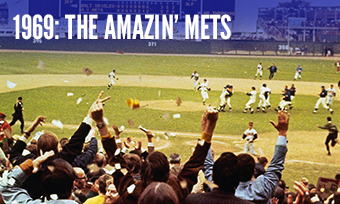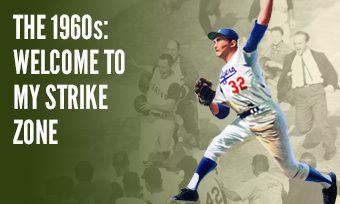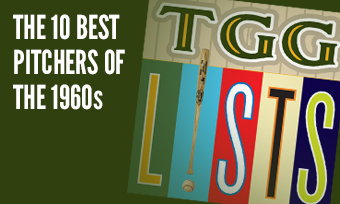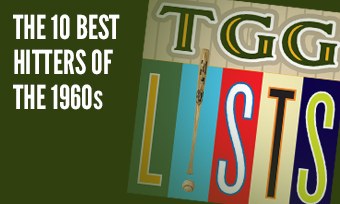The Yearly Reader
Leaders and Honors, 1969
Our list of baseball’s top 10 hitters and pitchers in both the American League and National League for the 1969 baseball season, as well as the awards and honors given to the game’s top achievers of the year.
The National League’s Top 10 Hitters, 1969
Bold type in brick red indicates league leader.
1. Willie McCovey, San Francisco
Key Numbers: .320 average, 101 runs, 26 doubles, 45 home runs, 126 RBIs, 121 walks, 45 intentional walks, .453 on-base percentage, .656 slugging percentage.
Stretch received long overdue respect—first from pitchers who granted him a then-record 45 intentional walks, followed by writers who voted him the NL MVP—and the MVP of the All-Star Game to boot.
2. Jim Wynn, Houston
Key Numbers: .269 average, 113 runs, 33 home runs, 87 RBIs, 148 walks, 23 stolen bases.
The diminutive but muscular “Toy Cannon” certainly saw the benefits of talent-diluted expansion and the elimination of the high strike zone that led to a 22% surge in walks, as his major league-leading pass total represented a career high.
3. Hank Aaron, Atlanta
Key Numbers: .300 average, 100 runs, 30 doubles, 44 home runs, 97 RBIs, 87 walks.
For the fourth and last time in his distinguished career, Aaron’s home run total matched his uniform number.
4. Pete Rose, Cincinnati
Key Numbers: .348 average, 120 runs, 218 hits, 33 doubles, 11 triples, 16 home runs, 82 RBIs, 88 walks.
Rose captured his second straight batting crown and hit for a career-high average, thanks to a .383 home figure produced in the Reds’ last full year at Crosley Field.
5. Bobby Bonds, San Francisco
Key Numbers: .259 average, 120 runs, 25 doubles, 6 triples, 32 home runs, 90 RBIs, 81 walks, 187 strikeouts, 45 stolen bases, 4 caught stealing.
A combination of blazing speed and bruising power left Bonds, in his first full season, poised to successfully follow on the coattails of a fading Willie Mays.
6. Tony Perez, Cincinnati
Key Numbers: .294 average, 103 runs, 185 hits, 31 doubles, 37 home runs, 122 RBIs.
For a guy who would unfairly gain the tag of a “supporting” star throughout his career, Perez but up some nifty marquee numbers.
7. Richie Allen, Philadelphia
Key Numbers: 118 games, .288 average, 79 runs, 32 home runs, 89 RBIs.
After forming a band called Rich Allen and the Ebonistics, Allen performed his swan song for the Phillies with a turbulent campaign that might have had him joining seven other players hitting 40-plus homers—had he not kept missing games and getting suspended for it.
8. Willie Stargell, Pittsburgh
Key Numbers: .307 average, 89 runs, 31 doubles, 6 triples, 29 home runs, 92 RBIs.
Among Stargell’s 29 home runs was the first completely hit out of Los Angeles’ Dodger Stadium; he’d hit the second, four years later.
9. Roberto Clemente, Pittsburgh
Key Numbers: 138 games, .345 average, 87 runs, 175 hits, 20 doubles, 12 triples, 19 home runs, 91 RBIs.
Less known for his muscular theatrics than his hit-machine output and remarkable throwing arm, Clemente clubbed three home runs in a game for the second time in three years.
10. Rusty Staub, Montreal
Key Numbers: .302 average, 89 runs, 166 hits, 26 doubles, 5 triples, 29 home runs, 79 RBIs, 110 walks.
After seven years in Houston, Staub relocated to Quebec and became an instant folk hero in Montreal, where the redhead was given the sobriquet Le Grand Orange.
The American League’s Top 10 Hitters, 1969
1. Reggie Jackson, Oakland
Key Numbers: .275 average, 123 runs, 36 doubles, 47 home runs, 118 RBIs, 114 walks, 20 intentional walks, 142 strikeouts, 13 stolen bases, .608 slugging percentage.
Jackson exploded onto the scene by hammering 37 homers before the All-Star break; he was the first player to knock in 10 runs in a game since 1955.
2. Harmon Killebrew, Minnesota
Key Numbers: 162 games, .276 average, 106 runs, 49 home runs, 140 RBIs, 145 walks, 20 intentional walks, .427 on-base percentage.
Killer’s marginal batting average was offset with a slew of walks that gave him a higher on-base percentage than first-time AL batting champ (and fellow Twin) Rod Carew; it was all enough to be granted with his only MVP.
3. Frank Robinson, Baltimore
Key Numbers: .308 average, 111 runs, 19 doubles, 5 triples, 32 home runs, 100 RBIs, 88 walks, 13 hit-by-pitches.
Robinson returned to stellar, everyday form in arguably his best year since his triple-crown effort of 1966
4. Frank Howard, Washington
Key Numbers: .296 average, 111 runs, 175 hits, 48 home runs, 111 RBIs, 102 walks, 29 grounded into double plays.
Under the first-year guidance of Senators manager Ted Williams, Howard was taught the Splendid Splinter Method of being patient at the plate; it resulted in nearly double the walks and two-thirds the strikeouts from the year before, while maintaining his power.
5. Rico Petrocelli, Boston
Key Numbers: .297 average, 92 runs, 32 doubles, 40 home runs, 97 RBIs, 98 walks.
The sixth-year Red Sock, father of future O.J. Simpson prosecutor Daniel Petrocelli, found the real killer instinct as he became the first AL shortstop ever to hit 40 homers—this, after never hitting more than 18 in any other season.
6. Sal Bando, Oakland
Key Numbers: 162 games, .281 average, 106 runs, 171 hits, 25 doubles, 31 home runs, 113 RBIs, 111 walks, 11 hit-by-pitches.
Lost in the Reggie Jackson hoopla in Oakland was the sudden advancement of Bando, who for the second straight year played all 162 games but greatly enhanced his output from the nine homers, 67 RBIs and 51 walks accrued in 1968.
7. Boog Powell, Baltimore
Key Numbers: .304 average, 83 runs, 25 doubles, 37 home runs, 121 RBIs.
In a career that fluctuated back-and-forth between good Boog and bad Boog, the former showed up with what could have earned him a third Comeback of the Year award (Tony Conigliaro won it instead).
8. Mike Epstein, Washington
Key Numbers: .131 games, .278 average, 30 home runs, 85 RBIs, 85 walks, 10 hit-by-pitches.
Like Frank Howard above, Epstein greatly benefitted from the presence of Ted Williams, putting together a career-year effort.
9. Carl Yastrzemski, Boston
Key Numbers: 162 games, .255 average, 96 runs, 28 doubles, 40 home runs, 111 RBIs, 101 walks, 15 stolen bases.
Yaz was rewarded with a then-AL record $130,000 contract—but lost $500 of that late in the season when manager Dick Williams fined him for not hustling. Still, he paired with Rico Petrocelli to become the first pair of Red Sox hitters to each belt 40 homers in a season—reaching the milestone with a last-game round-tripper.
10. Tony Oliva, Minnesota
Key Numbers: .309 average, 97 runs, 197 hits, 39 doubles, 24 home runs, 101 RBIs, 10 stolen bases.
Oliva’s bid for a third batting title to close out the 1960s was spoiled when he leveled off over the last month-plus of the season. He finished third below teammate Rod Carew.
The National League’s Top 10 Pitchers, 1969
1. Juan Marichal, San Francisco
Key Numbers: 2.10 ERA, 21 wins, 11 losses, 36 starts, 27 complete games, 8 shutouts, 299.2 innings, 54 walks, 15 caught stealing/picked off.
Marichal’s continued greatness finally nabbed him his one and only ERA title—but not the Cy, as he didn’t even get a single vote. (Full disclosure: Voters only had one a first-choice option.)
2. Bob Gibson, St. Louis
Key Numbers: 2.18 ERA, 20 wins, 13 losses, 35 starts, 28 complete games, 314 innings, 269 strikeouts.
Gibson was no longer superhuman as he fumed over the loss of the high strike, but his ERA was still the majors’ third best; six times he continued into extra innings—four of those over his last five starts.
3. Bill Singer, Los Angeles
Key Numbers: 2.34 ERA, 20 wins, 12 losses, 40 starts, 315.2 innings.
Singer set himself a goal to win 18 games—or three a month; the man who never won more than 13 sold himself short.
4. Larry Dierker, Houston
Key Numbers: 2.33 ERA, 20 wins, 13 losses, 37 starts, 305.1 innings, 24 grounded into double plays.
Amid the Astro workhorses of the 1970-80s (Don Wilson, J.R. Richard, Nolan Ryan, Mike Scott), no one threw for more innings in one year than Dierker in 1969. He was the Astros’ first 20-game winner on a team with its best record yet, at 81-81.
5. Tom Seaver, New York
Key Numbers: 2.21 ERA, 25 wins, 7 losses, .781 win percentage, 35 starts, 273.1 innings.
Seaver won each of his last eight starts—all of them complete games—while opponents went 0-for-13 with no walks when the bases were loaded against him.
6. Claude Osteen, Los Angeles
Key Numbers: 2.66 ERA, 20 wins, 15 losses, 41 starts, 7 shutouts, 321 innings, 37 grounded into double plays.
Osteen set a career mark with 20 wins, once more proving that the 1964 trade sending him from Washington to Los Angeles for Frank Howard continued to work out well for both teams.
7. Jerry Koosman, New York
Key Numbers: 2.28 ERA, 17 wins, 9 losses, 32 starts, 241 innings, 25 grounded into double plays.
Like his ace-in-arms Tom Seaver, Koosman thrived down the stretch, winning eight of his last nine decisions—followed by both of his World Series starts.
8. Steve Carlton, St. Louis
Key Numbers: 2.17 ERA, 17 wins, 11 losses, 31 starts, 236.1 innings.
The young Lefty’s shot at an ERA title blew up when he entered his final start with a 1.98 figure—then gave up five runs in just a third of an inning at New York against the Mets.
9. Bill Hands, Chicago
Key Numbers: 2.49 ERA, 20 wins, 14 losses, 41 starts, 300 innings, 23 grounded into double plays.
Along with Ferguson Jenkins, Hands became part of the first 20-win Cubs duo since Lou Warneke and Bill Lee in 1935.
10. Phil Niekro, Atlanta
Key Numbers: 2.56 ERA, 23 wins, 13 losses, 40 appearances, 35 starts, 284.1 innings, 57 walks, 15 wild pitches.
Always worthy but sometimes wacky; Niekro twice threw four wild pitches in a game. No other pitcher threw more than three in any 1969 appearance.
The American League’s Top 10 Pitchers, 1969
1. Mike Cuellar, Baltimore
Key Numbers: 2.38 ERA, 23 wins, 11 losses, .676 win percentage, 39 starts, 290.2 innings, 27 grounded into double plays.
Another one that got away from the Astros (along with Rusty Staub and, eventually, Joe Morgan and Jim Wynn), Cuellar took his best-of-era screwball to Baltimore and began a six-year period averaging 21 wins a season.
2. Fritz Peterson, New York
Key Numbers: 2.55 ERA, 17 wins, 16 losses, 37 starts, 272 innings, 43 walks, 28 grounded into double plays.
The majors’ overall upsurge in offense didn’t help Peterson’s prospects to win 20 games, as the Yankees supported him to the tune of just 2.95 runs per start.
3. Mel Stottlemyre, New York
Key Numbers: 2.82 ERA, 20 wins, 14 losses, 39 starts, 24 complete games, 303 innings, 39 grounded into double plays.
The current Yankees ace (and their future pitching coach) had better luck getting offensive backing than Peterson, reaching the 20-win mark for the second straight year and third time overall.
4. Jim Perry, Minnesota
Key Numbers: 2.82 ERA, 20 wins, 6 losses, .769 win percentage, 46 appearances, 36 starts, 261.2 innings, 26 grounded into double plays.
Perry re-emerged after a series of frustrating years trying to break back into the Twins’ rotation on a full-time basis, even out-winning his brother Gaylord by one. He was 14-1 at Metropolitan Stadium.
5. Denny McLain, Detroit
Key Numbers: 2.80 ERA, 24 wins, 9 losses, .727 win percentage, 41 starts, 23 complete games, 9 shutouts, 325 innings, 67 walks, 24 stolen bases allowed.
A 24-9 record seems rather banal after winning 31 the year before, but McLain was still acknowledged as one of the best, earning AL Cy co-honors with Mike Cuellar.
6. Dick Bosman, Washington
Key Numbers: 2.19 ERA, 14 wins, 5 losses, .737 win percentage, 31 appearances, 26 starts, 193 innings, 39 walks.
One of the primary reasons the Senators finished above .500 for the only time within the franchise’s first 13 years of existence was Bosman, who graduated to the rotation in 1969 and became the first ERA champ wearing a Senators/Rangers jersey.
7. Sam McDowell, Cleveland
Key Numbers: 2.94 ERA, 18 wins, 14 losses, 38 starts, 285 innings, 279 strikeouts, 14 wild pitches, 24 grounded into double plays.
The Indians’ ace held the fort as best he could as the team around him collapsed to a 99-loss record; after him, the Cleveland rotation combined for a 27-58 record.
8. Jim Palmer, Baltimore
Key Numbers: 2.34 ERA, 16 wins, 4 losses, .800 win percentage, 26 appearances, 23 starts, 6 shutouts, 181 innings.
Palmer proved his worth following two injury-riddled campaigns that actually left him unprotected—and untaken—in the expansion draft. After missing six weeks due to a torn back muscle in July, Palmer threw his lone career no-hitter in his second start back, against Oakland.
9. Andy Messersmith, California
Key Numbers: 2.52 ERA, 16 wins, 11 losses, 40 appearances, 33 starts, 250 innings, 100 walks, 16 wild pitches.
Winless with five losses through the end of May, the right-handed sophomore refreshed and shined the rest of the way, going 16-6 with a 2.14 ERA.
10. Dave McNally, Baltimore
Key Numbers: 3.22 ERA, 20 wins, 7 losses, .741 win percentage, 40 starts, 268.2 innings, 26 grounded into double plays.
McNally didn’t lose his first game until August 3—ending an impressive stretch of 45 starts in which he won 29 games and lost only two.









